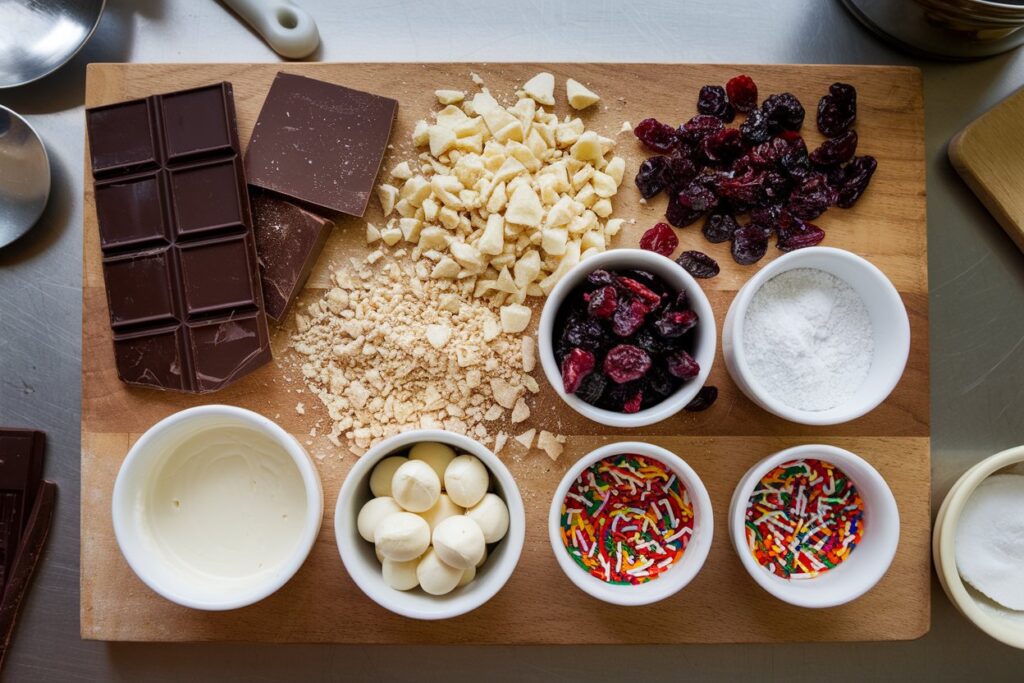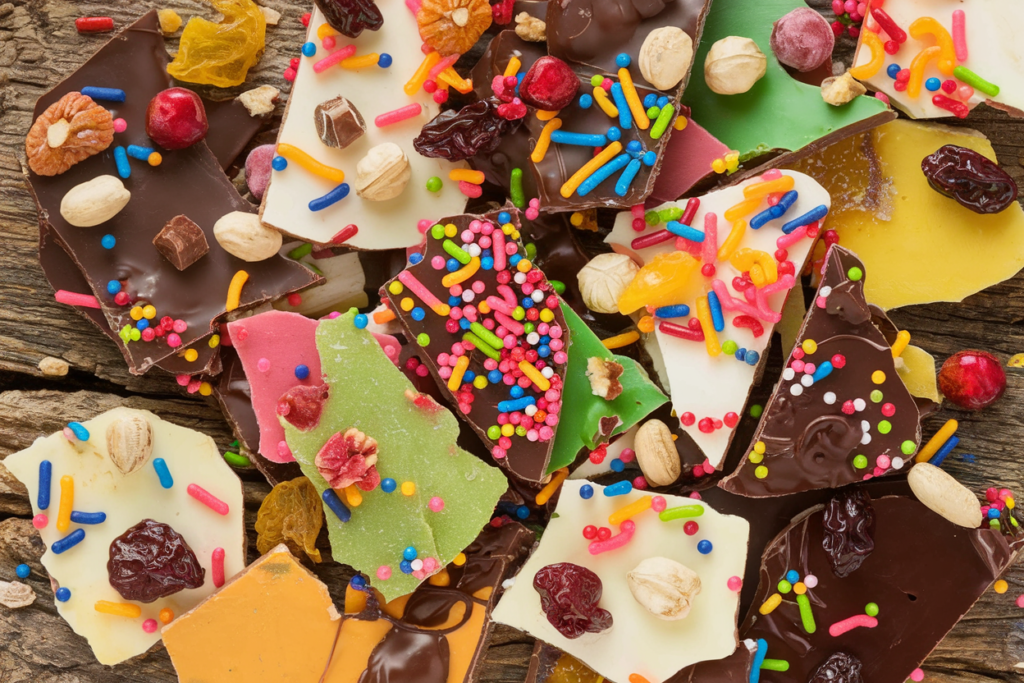A Sweet Treat Explored
Candy bark is a confectionery marvel loved by many for its versatility and simplicity. This delightful treat combines rich chocolate, nuts, dried fruits, and other mouthwatering toppings to create a delectable snack or gift-worthy dessert. Whether you’re curious about its history, ingredients, or the art of making it at home, this guide will answer your questions and more.
Let’s dive into the world of candy bark and uncover its secrets, starting with an introduction to what makes this treat so special.
Part 1: Introduction to Candy Bark
Understanding Candy Bark
Candy bark, often referred to simply as chocolate bark, is a layered dessert made primarily from melted chocolate adorned with an array of toppings. The name “bark” derives from its rough, textured surface that resembles tree bark.
Definition and Overview
At its core, candy bark is a combination of melted chocolate—milk, dark, or white—and toppings like nuts, dried fruits, sprinkles, or crushed candies. The beauty of this treat lies in its versatility; it can be as simple or elaborate as you want it to be. You can craft candy bark for holidays, special occasions, or even as a quick indulgence on a lazy day.
Historical Background
The history of candy bark is closely tied to the evolution of chocolate itself. Though no definitive origin exists, its popularity soared during the 20th century as chocolate became more accessible to home bakers. Companies like Ghirardelli and Lindt helped popularize variations like peppermint bark, a Christmas favorite. According to Candy History, peppermint bark became a cultural phenomenon in the 1960s, blending white and dark chocolate with crushed peppermint candy for a festive twist.
This background sets the stage for understanding why candy bark remains an enduring favorite across generations and cultures.
Part 2: Composition of Candy Bark

Core Ingredients
At the heart of candy bark lies its simplicity, which is part of its universal appeal. The base is almost always melted chocolate, serving as a delicious canvas for an array of toppings. Whether you prefer the creamy richness of milk chocolate, the bittersweet complexity of dark chocolate, or the sugary delight of white chocolate, the choice is yours.
The toppings range from crunchy nuts to chewy dried fruits, offering both flavor and texture contrasts. Additionally, additives like spices or extracts can transform the bark into a more unique treat. Despite its simplicity, the possibilities for customization are virtually endless.
Types of Chocolate Used
Chocolate is the backbone of candy bark. Choosing the right type ensures a harmonious flavor and proper texture.
- Milk Chocolate: Known for its creamy and sweet profile, milk chocolate is a favorite for those who enjoy softer, less bitter flavors.
- Dark Chocolate: With its intense cocoa flavor and lower sugar content, dark chocolate appeals to those seeking a more sophisticated and less sweet option. It also pairs beautifully with tart toppings like dried cranberries or cherries.
- White Chocolate: Though technically not a true chocolate (it contains no cocoa solids), white chocolate offers a luscious, buttery base that works particularly well with colorful toppings like sprinkles or crushed candies.
For the best results, tempering the chocolate ensures a glossy finish and a satisfying snap when broken. Chocolate Tempering Techniques can help achieve the perfect consistency, especially if you’re aiming for a professional look.
Inclusion of Nuts and Dried Fruits
One of the most beloved aspects of candy bark is its toppings. Nuts and dried fruits bring a delightful crunch and chewiness to the treat while introducing layers of flavor.
- Nuts: Almonds, pecans, pistachios, and walnuts are popular choices. They can be roasted to enhance their flavor or left raw for a milder taste.
- Dried Fruits: Options like cranberries, raisins, apricots, or even tropical fruits like mango add a natural sweetness that balances the chocolate’s richness.
- Combination of Both: Combining nuts and dried fruits creates a medley of textures and flavors, adding sophistication to this simple treat.
Use of Flavorings and Additives
To elevate candy bark from ordinary to extraordinary, flavorings and additives are essential. These enhancements are often subtle but profoundly impactful.
- Extracts and Spices: Vanilla extract, almond extract, or even peppermint oil can infuse the chocolate with distinct aromas. Spices like cinnamon or chili powder add an unexpected twist.
- Textural Additives: Crushed pretzels, toffee bits, or even rice cereal create a delightful crunch.
- Decorative Elements: Toppings like edible glitter, colored sprinkles, or holiday-themed decorations make the bark visually appealing for special occasions.
By experimenting with these components, candy bark can be tailored to suit any palate, occasion, or mood.
Part 3: Variations of Candy Bark
Popular Variants
The versatility of candy bark is one of its most exciting features. From holiday favorites to everyday indulgences, this treat adapts effortlessly to different themes, ingredients, and occasions. Some variants have become iconic, offering unique flavor combinations that cater to diverse preferences.
Peppermint Bark
A holiday classic, peppermint bark is a beloved variant that features a harmonious blend of chocolate and mint. This variety typically combines layers of dark and white chocolate, topped with crushed peppermint candies.
The contrast between the smooth chocolate and the crunchy peppermint bits creates a festive texture that’s synonymous with the holiday season. Peppermint bark is often given as a gift, packaged in decorative tins or cellophane bags, making it a staple during Christmas time. According to Candy History, this variant gained mainstream popularity in the 1960s and remains a holiday favorite.
Almond Bark
For those who prefer a nuttier treat, almond bark is a delicious option. This variant uses roasted almonds as the star topping, pairing beautifully with dark or milk chocolate.
Almond bark is celebrated for its simplicity. The nuts not only provide a satisfying crunch but also add a hint of natural sweetness and a healthy dose of protein. Many recipes incorporate slivered or chopped almonds, ensuring every bite is evenly packed with nutty goodness.
Chocolate Bark with Mixed Nuts
For a rich, indulgent twist, chocolate bark with mixed nuts offers an irresistible combination of flavors and textures. This variant combines an assortment of nuts—such as hazelnuts, cashews, pecans, and pistachios—layered over a base of melted chocolate.
Each nut contributes a unique flavor profile:
- Hazelnuts: Creamy and earthy, they pair wonderfully with dark chocolate.
- Cashews: Buttery and mildly sweet, these nuts balance out bitter chocolate varieties.
- Pecans: Slightly caramelized when roasted, they add depth to milk chocolate.
- Pistachios: With their bright green hue, pistachios offer visual appeal and a distinctive taste.
This variant is often customized with a sprinkle of sea salt or a drizzle of caramel, creating a gourmet dessert that feels both luxurious and approachable.
Each of these variations highlights the adaptability of candy bark, proving that there’s a version for every palate and occasion.
Part 4: Making Candy Bark at Home
Homemade Candy Bark Recipes
Creating candy bark at home is as simple as it is satisfying. Whether you’re preparing a sweet snack for yourself or crafting a thoughtful gift, homemade candy bark offers endless opportunities for creativity. With just a few basic ingredients and some easy techniques, anyone can make this delicious treat in no time.
Step-by-Step Guide
Here’s a foolproof method for making candy bark that even beginners can follow:
- Prepare Your Workspace: Line a baking sheet with parchment paper to prevent sticking.
- Melt the Chocolate: Use a double boiler or microwave to gently melt your choice of chocolate. Stir frequently to ensure a smooth consistency.
- Spread the Chocolate: Pour the melted chocolate onto the prepared sheet and spread it evenly using a spatula. Aim for a thickness of about 1/4 inch.
- Add Toppings: Sprinkle your chosen toppings—nuts, dried fruits, sprinkles, or crushed candies—over the chocolate while it’s still warm. Press gently to adhere them to the surface.
- Let It Set: Allow the bark to cool and harden completely. This can be done at room temperature or by placing the tray in the refrigerator for quicker results.
- Break Into Pieces: Once set, break the bark into irregular pieces and enjoy!
Tips for Customization
The beauty of homemade candy bark lies in its flexibility. Here are some tips to make it your own:
- Experiment with Layers: Try layering dark and white chocolate for a marbled effect.
- Seasonal Themes: Use holiday-themed toppings like red and green sprinkles for Christmas or pastel candies for Easter.
- Drizzle and Decorate: After the base layer sets, drizzle another chocolate type on top for added visual appeal.
- Go Savory-Sweet: Add a pinch of sea salt, pretzels, or even roasted chickpeas for a surprising twist.
Common Mistakes to Avoid
Even though making candy bark is straightforward, a few missteps can affect the final product. Avoid these common pitfalls for perfect results:
- Overheating Chocolate: Chocolate that’s overheated becomes grainy. Use gentle heat and stir continuously for smooth, melted chocolate.
- Skipping Tempering: For a glossy finish and crisp snap, tempering is essential, especially for dark or white chocolate.
- Using Moisture-Rich Toppings: Ingredients like fresh fruits can cause the chocolate to seize or spoil quickly. Stick to dried toppings.
- Rushing the Cooling Process: While it’s tempting to speed things up, rapid cooling in the freezer can sometimes cause the chocolate to crack.
- Not Storing Properly: Always store candy bark in an airtight container to maintain its texture and flavor.
By following these steps and tips, you can create a perfect batch of candy bark that’s as delicious as it is beautiful.
Part 5: Nutritional Information
Nutritional Profile of Candy Bark
While candy bark is undeniably delicious, understanding its nutritional makeup helps you enjoy it mindfully. This treat varies widely in nutritional content depending on the type of chocolate and toppings used. Whether you’re concerned about calories, sugar levels, or allergens, the information below provides insights into what you’re indulging in with each bite.
Caloric Content
The caloric content of candy bark depends heavily on its ingredients.
- Chocolate Base:
- Milk chocolate averages about 150 calories per ounce.
- Dark chocolate contains around 170 calories per ounce, with a higher cocoa content often contributing to a richer flavor but more calories.
- White chocolate, being the sweetest and creamiest, is also calorie-dense at about 160 calories per ounce.
- Toppings:
- Nuts like almonds or pecans add approximately 40–50 calories per tablespoon.
- Dried fruits like cranberries or raisins contribute about 25–30 calories per tablespoon.
A typical serving of candy bark (about 2 ounces) can range from 250 to 400 calories, depending on how decadent your creation is.
Sugar and Fat Levels
Candy bark, as expected, is rich in sugar and fat.
- Sugar Content:
Chocolate is the primary source of sugar in candy bark.- Milk and white chocolate have higher sugar levels, averaging 10–15 grams of sugar per ounce.
- Dark chocolate, especially varieties with over 70% cocoa, contains significantly less sugar, around 5–7 grams per ounce.
- Fat Content:
The chocolate base contributes to candy bark’s high fat content, primarily from cocoa butter.- Milk chocolate and white chocolate contain 8–10 grams of fat per ounce.
- Dark chocolate, being richer, contains about 12 grams of fat per ounce.
Adding nuts increases the healthy fat content, particularly unsaturated fats, which can be a nutritional perk when consumed in moderation.
Presence of Allergens
When it comes to allergens, candy bark can be a minefield, especially for those with food sensitivities or dietary restrictions.
- Nuts: Nuts like almonds, pistachios, or hazelnuts are common toppings and a significant allergen. Always label your homemade bark if gifting it.
- Dairy: Most chocolates, particularly milk and white chocolate, contain milk solids, making them unsuitable for those with lactose intolerance or a dairy allergy.
- Gluten: While chocolate itself is typically gluten-free, some toppings like pretzels, cookies, or toffee bits may contain gluten.
- Soy: Many chocolates contain soy lecithin as an emulsifier, which can be an issue for those with soy allergies.
To make candy bark inclusive, consider using allergen-free chocolate brands and toppings. For example, vegan chocolate is an excellent option for those avoiding dairy, while nut-free recipes eliminate the risk for individuals with nut allergies.
Understanding these aspects ensures that candy bark can be enjoyed responsibly and tailored to suit different dietary needs.
Part 6: Frequently Asked Questions
Curious about candy bark? From its origins to storage tips and dietary modifications, this section answers some of the most commonly asked questions. Let’s explore everything you need to know about this versatile treat.
What is the origin ?
The exact origin of candy bark is a bit hazy, but it’s closely tied to the history of chocolate confections. Bark-style desserts likely stemmed from the concept of blending chocolate with crunchy toppings, a method that gained popularity in the 20th century.
In particular, peppermint bark is often credited with popularizing the term “bark.” According to Candy History, peppermint bark was introduced in the 1960s and quickly became a holiday favorite. The layered design, which resembles tree bark, gave the treat its name.
Today, people enjoy it worldwide, creating endless variations tailored to local tastes and traditions.
How can you make candy bark without nuts?
Absolutely! While nuts are a common topping, you can make candy bark without them to cater to nut-free diets or personal preferences.
Here are some nut-free alternatives for toppings:
- Dried Fruits: Cranberries, apricots, or mango slices add a sweet and chewy texture.
- Crushed Candies: Peppermints, toffee bits, or caramel shards provide crunch and sweetness.
- Sprinkles and Edible Glitter: Perfect for adding a pop of color, especially for themed occasions.
- Savory Options: Pretzel pieces or sea salt flakes introduce a salty contrast to the sweet chocolate.
By swapping nuts for other ingredients, you can still enjoy a delicious, allergy-friendly candy bark.
How do you store candy bark?
Proper storage is essential to maintain the freshness and texture of candy bark. Follow these tips to store it effectively:
- Room Temperature: Store candy bark in an airtight container at room temperature for up to 2 weeks. Keep it in a cool, dry place, away from direct sunlight and humidity.
- Refrigeration: If your home is warm, you can refrigerate the bark in an airtight container. However, note that refrigeration might cause the chocolate to develop a white bloom due to temperature fluctuations.
- Layering: When storing multiple layers of bark, place parchment or wax paper between each layer to prevent sticking.
These steps ensure your candy bark stays as fresh as the day you made it.
Is there a vegan version of candy bark?
Yes, vegan candy bark is a fantastic option for those avoiding animal products. The process is just as simple, with a few ingredient substitutions:
- Chocolate: Use dairy-free chocolate or brands specifically labeled vegan. Dark chocolate with high cocoa content is often naturally vegan.
- Toppings: Avoid toppings like dairy-based toffee bits or milk chocolate candies. Opt for vegan-friendly toppings such as dried fruits, nuts, and crushed vegan candies.
- Flavorings: Use plant-based flavor extracts and avoid anything containing hidden dairy or animal-derived ingredients.
Everyone can enjoy vegan candy bark, which tastes just as indulgent as the traditional version, regardless of dietary restrictions.
What is the shelf life of homemade candy bark?
Homemade candy bark typically has a shelf life of 2–3 weeks when stored properly. However, certain factors can influence its longevity:
- Chocolate Quality: Higher-quality chocolate tends to last longer without losing flavor or texture.
- Toppings: Perishable toppings like fresh fruits will shorten the shelf life significantly. Stick to dried toppings for maximum longevity.
- Storage Conditions: Airtight containers and cool, dry environments are key to extending shelf life.
If you’re planning to gift candy bark, prepare it no more than a week in advance to ensure freshness for the recipient.
Can Candy Bark Be Frozen for Later Use?
Yes, you can freeze candy bark to extend its freshness and enjoy it later. Follow these simple steps for the best results:
- Prepare: Wrap the candy bark tightly in plastic wrap or parchment paper to keep it well-sealed and prevent freezer burn.
- Store: Place the wrapped bark in an airtight container or a freezer-safe bag for extra protection.
- Thaw: When you’re ready to enjoy, remove the bark from the freezer and let it sit at room temperature for about 30 minutes before serving.
Freezing candy bark is an easy and effective way to preserve its texture and flavor.
Freezing works best for bark without delicate toppings like sprinkles, which may lose their texture. Properly frozen candy bark can last up to 3 months, making it a convenient option for future cravings.


